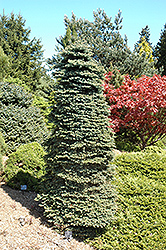Height: 15 feet
Spread: 4 feet
Sunlight:
![]()
![]()
Hardiness Zone: 3a
Other Names: Blue Colorado Spruce;Colorado Blue Spruce
Description:
A striking tree for sure, featuring bright blue-green needles on a narrow upright pyramidal form, with branches stiffly horizontal; best used as an accent, for adding dynamic interest to smaller home landscapes
Ornamental Features
Dwarf Blue Spruce is primarily valued in the landscape for its distinctively pyramidal habit of growth. It has attractive bluish-green evergreen foliage which emerges silvery blue in spring. The small needles are highly ornamental and remain bluish-green throughout the winter. The rough gray bark adds an interesting dimension to the landscape.
Landscape Attributes
Dwarf Blue Spruce is a dense evergreen tree with a strong central leader and a distinctive and refined pyramidal form. Its average texture blends into the landscape, but can be balanced by one or two finer or coarser trees or shrubs for an effective composition.
This is a relatively low maintenance tree. When pruning is necessary, it is recommended to only trim back the new growth of the current season, other than to remove any dieback. Deer don't particularly care for this plant and will usually leave it alone in favor of tastier treats. It has no significant negative characteristics.
Dwarf Blue Spruce is recommended for the following landscape applications;
- Accent
- Vertical Accent
Planting & Growing
Dwarf Blue Spruce will grow to be about 15 feet tall at maturity, with a spread of 4 feet. It has a low canopy with a typical clearance of 1 foot from the ground, and is suitable for planting under power lines. It grows at a slow rate, and under ideal conditions can be expected to live for 40 years or more.
This tree does best in full sun to partial shade. It is very adaptable to both dry and moist growing conditions, but will not tolerate any standing water. It is considered to be drought-tolerant, and thus makes an ideal choice for xeriscaping or the moisture-conserving landscape. It is not particular as to soil type or pH, and is able to handle environmental salt. It is highly tolerant of urban pollution and will even thrive in inner city environments. This is a selection of a native North American species.
Disclaimer - This resource is provided for informational purposes only and does NOT reflect current availability. Inventory varies seasonally, so we cannot guarantee that every plant will be in stock at all times - please contact your favourite GardenWorks location directly for current availability. It does not include our entire inventory of plants, so be sure to visit GardenWorks to see varieties that may not be represented on this list.

